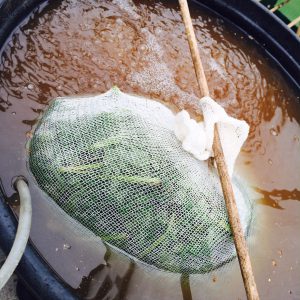Compost TE
Posted by REMY EKORNSETER


Neslevann is a word that has recently been on many people's lips in line with the interest in growing your own vegetables. Chili, like almost all other green plants, greatly appreciates nettle water. Now that nettles are putting out nice, fresh shoots, the time has come to harvest nourishment from nature. It is very easy and quick to do.
Traditionally, you take a bucket of water and dump nettle shoots or plants into the bucket and then leave it for a while. The result is a relatively foul-smelling solution that is very rich in nitrogen. And it is precisely nitrogen that we are looking to obtain from nettle. Nettles, like valerian and other "weeds", have the ability to shoot long roots that quickly pick up nitrogen from the soil to give the plant rapid growth in competition for space and light where they will naturally grow. Much of the nitrogen is in the stem and leaves and especially the young, new shoots. But why stop at the traditional nettle water. The world has come further and we can accomplish so much more by simple means. Compost tea is a well-known term for a few here at home, but very well-known in the wider world. The difference between brewing compost tea and nettle water is big. With compost tea, we "brewe" a nutritional brew rather than extracting a specific nutrient or two. The big, or rather, little secret is the introduction of oxygen into the solution. 
In stagnant solutions you can get anaerobic bacteria which are not always the bacteria you want in such a solution. And in extreme cases, especially in other countries with a different water quality to what we have, you can also get bacteria that are harmful to humans. By enriching the solution with oxygen, we will eliminate this danger. But the biggest difference is that we also cultivate bacteria and micro-life. By following this recipe, you will be able to give your plants the optimal nutrient solution we have so far arrived at. We love to innovate and we love to be efficient.
In short, you need a light-proof barrel/container with some kind of lid of at least 30l (the recipe will be for 40l and it can be adjusted to your size). You also need an air stone and an air pump. Whether you follow the instructions to the letter is up to you. For us, it is so far the most optimal brewing solution we have come up with for nitrogen. 
It starts simply by picking fresh nettle shoots and filling a normal carrier bag to the brim. If you see clover and wort, take them with you. In the brew, we use a hop bag from beer brewing as a tea bag. A stone is placed at the bottom as ballast before the bag is filled to the brim with the goodies you have been out picking. In the container we add approx. 1-2dl of bat guano, 3-4 tbsp of basalt, 0.5dl of nature's bio organic, neem cake and a good amount of malt extract and a small dose of dark syrup. The sugar contributes to the flourishing of bacteria (breakdown of glucose) and algae and together with the oxygen that is supplied, the aerobic bacteria will flourish, but most importantly not break down the nitrogen as certain anaerobic bacteria would do in the absence of oxygen. Microorganisms will thrive in the solution. Many of the algae that are supplied via the water and nature's bio organic will have a large bloom. But they must not be exposed to UV (sun) as they will die in a short time. 
Add the air stone and fill with water with a little pressure so that the ingredients mix well. Finally, put the tea bag in the water, turn on the air pump and put the lid on. Then you just have to wait a minimum of 3 days. The solution will foam and that is a good sign. When it is to be used, it is considered fresh and must be used continuously. Mix 1.5l with 8.5l of water and water the plants well. In return, the plants will greatly appreciate this.
We will come back later in the season with other variations where we focus on macronutrients other than nitrogen. Good luck


